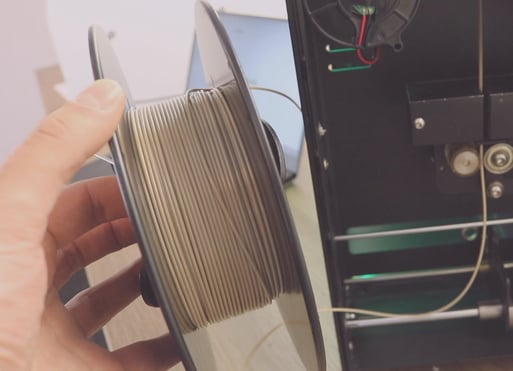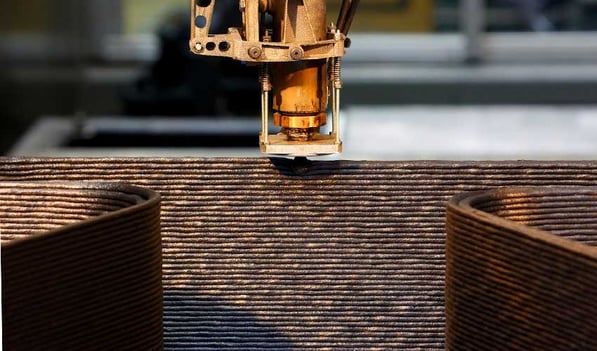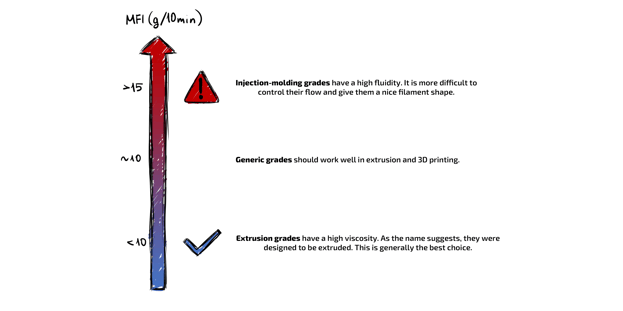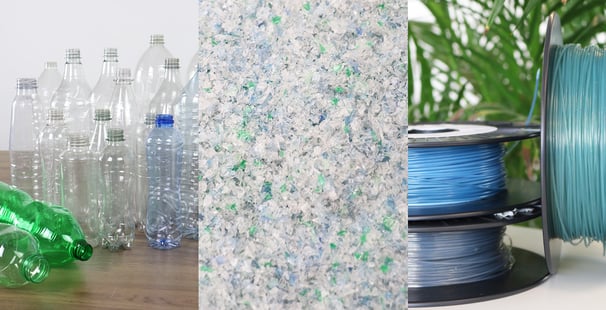Share this
The Complete Material Selection Guide for 3D Printing
by 3devo on May 23, 2022 12:01:00 PM

How-To Choose the Right Material for Your Application
Starting with the proper material selection is essential to getting the outcomes you want during extrusion and when 3D printing. You should choose your material based on its properties and its processability, not the possibilities you hope it’ll give you.
To help you along with your journey, we’ll take you through the different factors you should consider while giving you real-life examples, so you know how to go about the right material selection for your specific need. These factors include:
- Difficulty to 3D print or extrude the material
- Features available with your 3D printer or extruder
- Project requirements dependent on the material
- Choosing the correct material grade
- Complexities of using recycled plastic
- Creating composite materials with the use of additives
Difficulty to 3D Print or Extrude the Material
Not all materials have the same processability or require the same settings for filament extrusion. For example, high-temperature polymers such as PEEK, PEKK, and PEI require special processing, transition, and purging techniques. Therefore, it’s important to know and learn these techniques before you start experimenting to avoid clogging your filament maker.
Polymers such as PP and HDPE are challenging to solidify as round filaments due to high crystallinity. While they are very safe to process with out equipment, they take time to master from the start
Crystallites that can affect the roundness of some polymers
Project Requirements Dependent on the Material
What do you want to achieve with your project?
Before you decide on a material, define your needs carefully. Your material selection may become a variable in your project, so if several materials meet all your needs, it would be wise to choose the one that’s easier to process at the end of the day.
Copper Additive Testing
If you want to test PP with copper powder and if your goal is to experiment with the additive copper, you might want to start by adding the copper with PLA. Compared to PP, PLA is easier to extrude and print.
High Mechanical Strength
PEEK is the most popular option if you need a material with high mechanical strength and temperature resistance, but there are other materials to choose from, such as PEEK and PEI. If you decide on PEEK, keep in mind the many different grades of PEEK to choose from; some are easier to extrude than others.
 Spool of extruded PEEK filament
Spool of extruded PEEK filament
Choosing the Correct Material Grade
When considering which polymer to choose for your application, it is essential to know the different grades available. The grade of a polymer corresponds to one specific reference of a polymer type by one manufacturer.
ABS is a family of hundreds of grades of the same plastic. Each grade is unique, and luckily, each is usually associated with a specific technical data sheet that can help you with filament manufacturing or 3D printing. To simplify things, we can divide them into categories of types of grades.
The main difference between the categories is the flowing behavior of the molten polymer, which we can quantify with a clear viscosity indicator: the Melt Flow Index (MFI) in g/10min.
Using the Melt Flow Index
The MFI test is quite simple. It’s done by measuring the mass of molten polymer that can be pushed through a hole under standardized conditions. The higher the MFI, the more fluid the plastic is, but the lower its viscosity.
The MFI values are only estimates and not exact settings. The scale gives a general indication of which grades are easier to transform into filaments, but it does not mean that only extrusion grades can be processed with filament makers. Quite the contrary, our material specialists have been able to process many injection-molding grades successfully.
There are usually no material-technical datasheets for manufactured items. In this case, the MFI is unknown.
The Challenges of using Recycled Plastics
Recycling plastics usually comes with a few more challenges than processing virgin plastics. These challenges include:
Although these extra steps can be time consuming, but don’t let that stop you from trying! We have successfully extruded recycled plastic several times and have learned that it works well when all parameters are controlled.
- Collecting and sorting the parts
- Shredding the plastic
- Keeping the batch clean
- No datasheet as reference
Creating Composite Materials with the Use of Additives
What is a Composite Material?
Composites are typically composed of a polymer core and reinforcing material, such as chopped or continuous fiber. Composite materials have higher strength and stiffness than non-reinforced polymers and are capable of replacing some metals, such as aluminum.
Presently, chopped carbon fiber is the most popular composite material used in 3D printing. Carbon fiber pieces are mixed with other 3D printing plastics, such as nylon, ABS, and PLA.
 More companies are 3D Printing composites to maker parts (via 3DNatives)
More companies are 3D Printing composites to maker parts (via 3DNatives)
How to Create a Composite Material
In order to create a composite, the additive must be mixed with the base polymer. There are two ways to ensure that the additive is dispersed throughout the polymer.
- Premixing the additive and polymer through extrusion
Premixing the additive and polymer to form homogeneous pellets is usually done by twin-screw extrusion and making filament out of it. This method tends to let you achieve high additive proportions.- Directly feeding the polymer and additive into the hopper
By feeding the polymer and additive directly into the hopper of the filament maker*, the steps of mixing and filament production are combined. However, the risk of clogging the filament maker is higher.
*This is possible with our filament makers; please note that this might not be possible with other filament makers.When experimenting, it’s advisable to start with a small percentage of additives (usually 5%wt) and gradually increase the rate. The particle size of the additive is also crucial; sizes around 100 microns have been found to work very well.
Material Selection Summary
By choosing the right material and the right quality, you can achieve your goal effortlessly. A safe process allows you to quickly assess the workability of a particular grade and choose a different grade if necessary.
These guidelines can seem quite daunting, and you may focus on the limitations and constraints of material selection. But, in reality, they show the many opportunities and discoveries you can make in material selection and processing.
Share this
- November 2025 (1)
- October 2025 (1)
- March 2025 (1)
- January 2025 (1)
- December 2024 (2)
- November 2024 (2)
- October 2024 (4)
- September 2024 (2)
- August 2024 (3)
- July 2024 (6)
- June 2024 (3)
- May 2024 (2)
- April 2024 (1)
- March 2024 (1)
- January 2024 (1)
- November 2023 (2)
- October 2023 (5)
- September 2023 (2)
- August 2023 (1)
- July 2023 (1)
- May 2023 (1)
- December 2022 (2)
- June 2022 (1)
- May 2022 (2)
- April 2022 (2)
- March 2022 (6)
- February 2022 (2)
- January 2022 (3)
- December 2021 (3)
- November 2021 (3)
- October 2021 (2)
- September 2021 (3)
- August 2021 (3)
- July 2021 (2)
- June 2021 (1)
- March 2021 (1)
- October 2020 (1)
- June 2020 (1)
- May 2020 (1)
- April 2020 (4)
- November 2019 (1)
- July 2019 (2)
- June 2019 (1)
- May 2019 (1)
- March 2019 (1)
- November 2018 (1)
- September 2018 (1)
- January 2018 (1)
- October 2017 (1)
- September 2017 (1)
- July 2017 (1)
- June 2017 (1)
- May 2017 (1)
- January 2017 (1)
- December 2016 (3)
- November 2016 (2)
- October 2016 (1)
- May 2016 (2)
- August 2015 (2)
- July 2015 (1)

